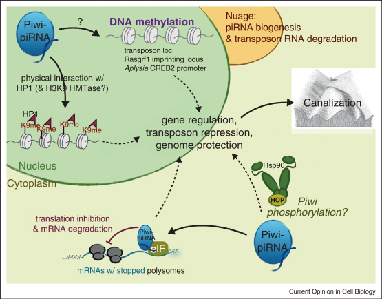
Research Interests
We study molecular mechanisms underlying the self-renewing division of stem cells. Currently, we focus on small RNA-mediated epigenetic programming and post-transcriptional regulation mechanisms that are required for the self-renewal of germline and embryonic stem cells. Meanwhile, we are exploring the clinical implications of our findings. Stem cells are characterized by their abilities to self-renew and to produce numerous differentiated daughter cells. Drosophila and the mouse represent two powerful systems for studying stem cells since they allow easy access to combined genetic, cell biological, and molecular analyses. We use Drosophila as a pilot model to explore molecular mechanisms underlying stem cell division, and the mouse as an advanced model to expand what we learn from Drosophila to mammalian and human systems. Previously, we identified germline stem cells in the Drosophila ovary and revealed their self-renewing asymmetric division. We and others showed that the asymmetric division of these stem cells is controlled by both niche signaling and intracellular mechanisms. Using systematic genetic screens, we have identified key genes involved in both niche signaling and intracellular regulation of stem cell division. Among them, piwi/argonaute genes represent the only known family of genes required for stem cell self-renewal in both animal and plant kingdoms. Currently, our research is focused on epigenetic programming and translational regulation of germline stem cell self-renewal mediated by the Piwi/Argonaute proteins and a novel class of non-coding small RNAs called piwi-Interacting RNAs (piRNAs) that we and others discovered in 2006. Meanwhile, we explore the role of these mechanisms in human embryonic stem cell division and oncogenesis.
Contributions We have made key contributions to the demonstration of stem cell asymmetric division, the proof of the stem cell niche theory, the discovery of the Argonuate/PIWI gene family and their essential function in stem cell self-renewal and germline development, as well as the discovery of a novel class of non-coding small RNAs called PIWI-interacting RNA (piRNA), which was hailed by the Science Magazine as one of the Ten Scientific Breakthroughs of 2006. We proposed and demonstrated the crucial function of piRNA in guiding epigenetic factors to their target sites in the genome.
Significance PIWI-piRNA mechanisms represent new paradigms of gene regulation that expand the central dogma of molecular biology and explain the function of many noncoding regions in the genome. These new mechanisms provide important answers to some of the missing puzzles in understanding cancers and degenerative diseases as well as new platforms for drug design and disease treatment.
Research in the Future Because the Piwi-piRNA complex exerts its functions via piRNA sequence specificity, the high complexity of piRNAs allows them to act on a wide range of targets in the genome, and to generate broad impact on genome-wide gene regulation at multiple levels. Of the many fascinating questions that remain, a few stand out. How does the Piwi-piRNA complex function in the somatic cells outside the germline, with apparently few piRNA molecules present How do Piwi-piRNA complexes interact with canonical epigenetic machinery in the nucleus to achieve epigenetic programming And, whether/how do proteins interact with tens of thousands of different piRNAs in the cytoplasm to regulate gene expression Answers to these questions will represent significant advancement in our understanding of the piRNA biology. |
